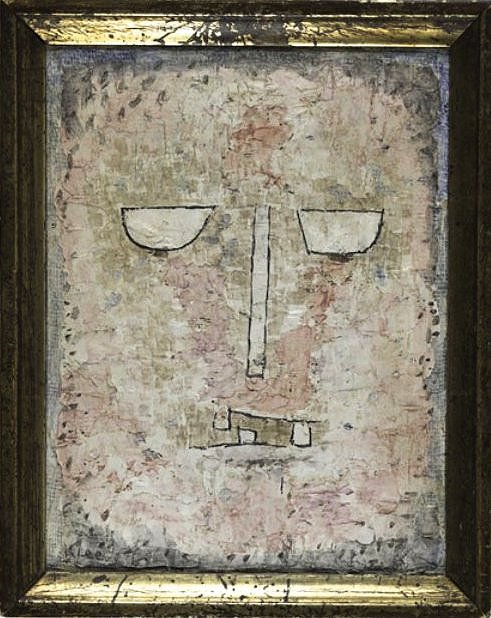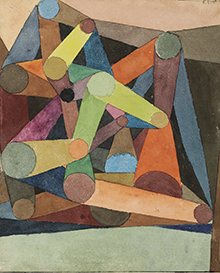From August 10 to November 9, 2003 the Fondation Beyeler presented a comprehensive review of the late work of Paul Klee. Beginning with the exquisitely colored pointillism of the Düsseldorf years (1931-32), through Klee’s emigration to Switzerland in 1933 as a result of the Nazi takeover, to the artist’s death in 1940, the exhibition represents every facet of this rich and productive final phase of his career.
The exhibition was conceived in collaboration with the Sprengel Museum, Hanover. It resulted from a need felt by both of our institutions, each harboring a significant Klee collection, to convey a valid picture of the rich and varied development of the work created by this German artist who chose exile in his homeland during the Third Reich.
The exhibition focused on a great overarching theme which holds significance not only for the art of the past but for modernism as well – that of the “late work”. We should recall that it was the major late work of artists of the waning nineteenth century – Cézanne, van Gogh, Monet – that provided crucial impulses to modern art. When in the second third of the twentieth century a few major representatives of the ever-young avant-garde themselves suddenly faced the “last things”, the ultimate questions of existence, remarkable turns often resulted. There emerged aesthetic idioms of great compellingness: the precursors of the “modern late work.” Those of especially outstanding quality included, apart from Matisse’s, the late work of Klee, which at the same time represented one of the earliest “stocktakings” in modern art.
After a long, successful teaching career at the Bauhaus, in Weimar and Dessau, Klee was offered a professorship at the Düsseldorf Academy. This marked the beginning of his renowned “pointillist” phase, in which his colorism reached an apex of subtlety and concision. Yet this superb, finely articulated style found an abrupt end when, after the Nazis came to power, Klee was suspended from his post in April 1933. In December of that year he emigrated to Bern, the city of his boyhood and youth, which from then on he would seldom leave. With an impressive artistic effort Klee now abandoned the dreamworld of the Düsseldorf period for a visual language that was harsh, conden-sed, as if in reaction to injury. The pulsating, mythically evocative patterns of the pointillist phase gave way to the scars of a perception under duress. This break could be traced in the exhibition, at those points where major works of the Düsseldorf years are confronted with those from the fateful year 1933 and thereafter
(e.g. Head of a Martyr, 1933).
The next ceasura came in 1935. Klee fell seriously ill. His continually worsening symptoms would be diagnosed posthumously as incurable progressive scleroderma, or harding of the skin. From that point on, every painting could be considered as belonging to an emerging late work. At first, Klee’s creative powers collapsed – only 25 works were done in that especially difficult year of 1936. The exhibition brought together a number of key works of the two years 1935 and 1936, in which the Europe-wide political catastrophe was followed by Klee’s private tragedy.
Two aspects of the year 1936 deserve emphasis: on the one hand, we find a renewed interest in the constructing of forms, of the kind especially characteristic of the earlier Bauhaus years. The often fragile, intertwined graphic traces of the 1920s congealed into fields of meaning of a new poignancy. Examples are the threatening black arrow lying heavy on the lineatures of the
Affected Town,
or the black Gate to the Depth suddenly opening in a field of colored rectangles. On the other hand, suggestions of those black barlike lines began to appear
(After the Flood),
which, in conjunction with luminous colored grounds, would become characteristic of the final phases, from 1937 onwards.
A good three-fourths of the works on view originate from the years 1937-40, in which Klee’s style experienced a final condensation and his productivity peaked (1253 works in 1939 alone). The year 1937 had already brought a marked increase. Klee’s condition stabilized, and encouraged the vision of a new, fragile freedom sub specie aeternitatis. By this time the late style, with its dark lines and bars on a colored ground, was coming to complete maturity. In a sense, it showed Klee translating the mobility and ease of drawing into the more permanent terms of the painted image. Some of his lines began to suggest figures, others remained largely abstract, while still others developed into symbols and signs with potential linguistic reference or fraught with encoded meaning. Klee’s paintings and drawings now reflected a subtle interplay between an evocation of the condition humaine in all its ridiculousness, wisdom and tragedy, and metaphysical aspects of existence that remain inaccessible to the intellect.
The following years brought a further, surprising increase in Klee’s production. In 1938, especially, he executed many large-format paintings – including the largest he had ever done. This was the period of full maturity within the late work. The exhibition included several of these outstanding works, which also hold a place of prominence in the oeuvre as a whole
(
Forest Witches,
The Grey Man
and the Coast, Rich Harbour).
With consummate sovereignty the artist now began to address the great subjects of mythology, man’s inner journey, and the role of the artist as a mediator be-tween aesthetic form and the elemental forces of being.
Following the great, “symphonic” major works, the year 1939 was marked especially by a feverish drawing activity. This included an intensive concern with a special category of mediating beings – the angels. These are represented in the exhibition above all by one of those sequences of drawings which were characteristic of Klee’s final years.
If the years 1938 and 1939 brought an emotionally moving unfolding of a final abundance, the year 1940 stood under the sign of the irrevocably approaching “ultimate things.” Using an often dramatically heightened palette, Klee now evoked insights into the dark realm of transition.
Death and Fire,
Going Next Door,
and Boat Trip in Darkness
show, each in its own way, this aspect of the final, merciless engima that stood between the fatally ill artist and release. The exhibition closed with three of the famous works from the estate which Klee left untitled, but which have become known by such telling titles as
Captive (Figure of This World/Next World),
Last Still-Life,
and The Angel of Death.
All in all, the present exhibition provided an unprecedented insight into this late work, one of the first and most compelling in all of modernism. While other recent exhibitions of artists’ late oeuvres have tended to focus on some special facet of technique or on the production of a single year, the Fondation Beyeler exhibition gave the first review of Klee’s late work in all its breadth to have been seen for many years. Yet the emphasis, as rarely in the past decades, was purposely not placed on the frequently exhibited drawings, but on the paintings and major colored works on paper of this period. Still, the drawings were represented as well, in the form of selected sheets and series.
The exhibition brought together major loans from some of the finest Klee collections in Europe and the U.S. Foremost among these are the Paul-Klee-Stiftung in Bern, and the family collections of Livia Klee and Alexander Klee. Major works have also generously been made available by The Museum of Modern Art and the Metropolitan Museum, New York; the Kunstsammlung Nordrhein-Westfalen, Düsseldorf; the Sprengel Museum, Hanover; the Öffentliche Kunstsammlung, Basel; the Emanuel-Hoffmann-Stiftung; the Kunsthaus, Zurich; and further public and private lenders.
A catalogue was published in a bilingual edition (German and English) by Benteli Verlag, Bern. It includes essays by Matthias Bärmann, Ernst Beyeler and Ulrich Krempel, as well as a chronology by Stefan Frey. Approx. 200 pages with approx. 100 full-color illustrations.
From an excellent review of new Klee exhibition:
Opened Mountain, 1914 (detail). Photograph: Private collectionA work like Opened Mountain may have its origin in complex chromatic rhythms, but soaring above the method is the stupendous vision of intersecting light beams, or veins of precious minerals, in vermilion, gold and indigo – a wonderful party going on inside a sullen black crag.
They're Biting, 1920: ‘a fishing trip that hinges on a single imbalance’. Photograph: Tate
Father and son have cast their line from the bank, and contained in that marvellous arc are the sun, a boat, the water, the distant landscape and Klee's own signature, like a tiny insect alighting on the page, with the lugubrious fish hanging dumb-mouthed below. What a serene scene, what a perfect catch – except that an exclamation mark dangles before the fish by way of kindly warning.Fish are emblematic in Klee's art. One looks into his pictures as into an aquarium where the world is weightless, delicate, translucent and free, and time seems quite irrelevant.The clock submerged in Fish Magic, one of the show's most famous works, points uselessly to nine while the glittering creatures drift unhurriedly around it and strange discs glow in the dark like planets.
The rhythms of the cosmos are no more or less significant to the fish than the hours of the human clock.
More images:
Harmony of the Northern Flora
More reviews of new Klee exhibition:
http://article.wn.com/view/2013/10/20/Paul_Klee_Making_Visible_review/






.jpg!Blog.jpg)



